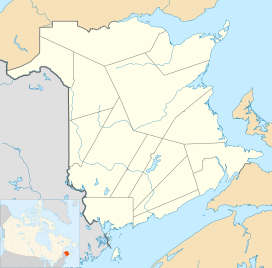Mount Pleasant Caldera
| Mount Pleasant Caldera | |
|---|---|
|
|
|
| Highest point | |
| Elevation | approx. 248 m (814 ft) |
| Listing | List of volcanoes in Canada |
| Coordinates | 45°30′01.35″N 66°45′16.31″W / 45.5003750°N 66.7545306°WCoordinates: 45°30′01.35″N 66°45′16.31″W / 45.5003750°N 66.7545306°W |
| Geography | |
| Location | Charlotte County, New Brunswick, Canada |
| Parent range | Appalachian Mountains |
| Topo map | 021G07 |
| Geology | |
| Age of rock | Late Devonian |
| Mountain type | Caldera |
| Climbing | |
| Easiest route | All-weather road |
The Mount Pleasant Caldera is a large eroded Late Devonian volcanic caldera complex, located in the northern Appalachian Mountains of southwestern New Brunswick, Canada. It is one of few noticeable pre-Cenozoic calderas, and its formation is associated to a period of crustal thinning that followed the Acadian orogeny in the northern Appalachian Mountains. It sits relatively near to the coastline.
The large elliptical feature is dated back to the late Devonian Period, and is partially covered in the north by overlying Middle Mississippian and Pennsylvanian Period strata. The volcano is north-south trending in its elliptical shape, with minimum dimensions of 13 by 34 kilometres (8 mi × 21 mi) as outlined by regional gravitational and magnetic studies. The northern half of the volcano has since been covered by depositional rock strata. The caldera is bounded to the east and west by fused Ordovician to Silurian turbiditic metasedimentary rocks of the local Digdeguash and Flume Ridge geological formations.
Late Silurian to Devonian granitic rocks of the Saint George Batholith bound part of the southern margin of the caldera. Rocks within the summit itself date back to the Upper Devonian, and show multiple fill sequences late in its history.
The magma produced by Pleasant is rich in silica, as indicated by a large amounts of ignimbrite, tuff, rhyolite, and other igneous rocks rich in the mineral. Silica-rich magma does have a high viscosity, and therefore does not flow easily like basalt. As a result, gases tend to become trapped at high pressure within the magma. When the magma approaches the surface of the Earth the rapid off-loading of overlying material causes the trapped gases to decompress rapidly triggering explosive destruction of the magma and spreading volcanic ash over wide areas.
...
Wikipedia

